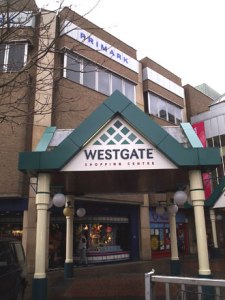Six and a half years after promising to reform the UK’s arcane business rates system, Chancellor George Osborne announced some sweeping changes at the Conservative Party conference on Monday.
However, instead of a carefully thought out progressive revision of local business taxation, we had yet more fudge from a Willy Wonka chancellor, eager to impress the party faithful with a plan so fiendish even Blackadder would blush at its audacity.
Currently business rates are levied by central government and collected on its behalf by local authorities who then pass the money to the Treasury. A portion of this is subsequently returned to councils to fund local services. This is the process of the Uniform Business Rate system, or UBR, a scheme instigated by Margaret Thatcher, partly with the intention of evening out disparities between richer and poorer areas of the country and re-distributing that wealth more fairly. Yes, even Maggie was a little bit commie on the quiet.
The problem in recent years though has been that rates have sky-rocketed in line with the rental valuations to which they are inexorably tied. The retail boom in the early part of the new century drove landlords to expect more and more returns on property. With large, heavily-leveraged retail chains eager to stump up ridiculous amounts of rent to be in key locations, the market mushroomed.
 Consequently business rates have generated massive piles of wonga for central government and successive chancellors of every hue haven’t exactly been itching to relinquish the embarrassment of riches they’ve had bestowed on them. Indeed in 2012 alone, £350M was added to the rates liabilities of businesses amidst one of the worst recessions on record. During the last parliament the business rates take ballooned by over £1bn and the situation has been further exacerbated by the arbitrary postponement of the regular 5 yearly rating revaluation which should have taken place this year.
Consequently business rates have generated massive piles of wonga for central government and successive chancellors of every hue haven’t exactly been itching to relinquish the embarrassment of riches they’ve had bestowed on them. Indeed in 2012 alone, £350M was added to the rates liabilities of businesses amidst one of the worst recessions on record. During the last parliament the business rates take ballooned by over £1bn and the situation has been further exacerbated by the arbitrary postponement of the regular 5 yearly rating revaluation which should have taken place this year.
Pressure has therefore been mounting on government from businesses and retail campaigners like myself to do something about the damage this system is wreaking on our local high streets. This reached something of a crescendo prior to the general election, when once again the Conservatives promised that improvements would be made, even though they’d singularly dodged the issue throughout the previous five years.
So it was surprising that there was scant mention of rates in the emergency budget cobbled together by Osborne just after The Conservatives shock victory in May. I think I now we see the reason why. He’s obviously confused his party conference with budget day.
Devolution Illusion
Rather than kick this thorny little ball into the long grass for a few more years, Gorgeous George included in his keynote speech the wizard wheeze of passing the problem back to local councils under the guise of localism. The plan is simply to abolish UBR – the one part of the current regime that actually has any merit – and allow councils to hang on to all the money they collect from local businesses, regardless of the disparity that will result.
Apparently eschewing any further rounds of tokenistic consultation with business leaders, he’s neatly avoided central government having to find a solution to the whole soggy mess. In a move that sounds like it was thought up after a particularly good session in the House of Commons bar, he’s dropped the problem into the lap of local councils and walked away. Bang! Sorted!
However, Osborne’s claims about the benefits of his grand idea show just how staggeringly little he understands about the way the system actually works. Something that’s probably a teeny bit worrying coming from our Chancellor, considering we’re talking about a major plank of our national fiscal structure.
Bold Claims
He claims that giving Local authorities the power to reduce rates will help them attract new businesses to the area. In this bold statement he seems to be lamentably ignorant of the fact that councils have had the power to reduce rates since the Localism Act was introduced by his government in 2011. But like so many of these devolution illusions, giving people the ability to do something doesn’t mean they can actually do it.
He’s dropped the problem into the lap of local councils and walked away. Bang! Sorted!
Most councils struggle on the budgets they have already, any decreases in rates payments have to be taken out of that already dwindling sum and so hardly any have availed themselves of their new powers. Sweeping away the last vestige of Thatcherite socialism will only serve to exacerbate these problems, not make things better.
The Chancellor also seems to be unaware of the fact that empty properties still attract a rates liability. Landlords continue to pay rates on voids with only a small amount of relief in the early stages of a vacancy, so there’s little incentive for councils to reduce rates on empty properties. A problem that I once tried to explain to our erstwhile minister for the high street, Grant Shapps, without much success. It appears that obliviousness to the principles of local taxation goes even higher than I thought. Which explains a lot.
 Rates will therefore continue to be an unavoidable burden weighing particularly heavily on small retailers, especially as, under Osborne’s new scheme, it appears that central government will still be setting the national levy as it does now. I say ‘appears’ as the details seem to be thin on the ground right now. Perhaps George lost the fag packet he wrote them on somewhere between the conference podium and the bar.
Rates will therefore continue to be an unavoidable burden weighing particularly heavily on small retailers, especially as, under Osborne’s new scheme, it appears that central government will still be setting the national levy as it does now. I say ‘appears’ as the details seem to be thin on the ground right now. Perhaps George lost the fag packet he wrote them on somewhere between the conference podium and the bar.
There is some talk about a system of re-distributing funds between richer and poorer councils, but again there are not many specifics beyond the idea that city councils who agree to have an elected mayor will be allowed to impose small additional levies for infrastructure projects, again something they can already do now.
There may be some scope for individual councils to adjust liabilities between different types and levels of business, but without the ability to increase rates on others beyond government limits, that will only work in one direction.
Rich and Poor
Well heeled and over-subscribed areas like London’s West End will reap huge rewards from this new regime, hanging on to far more money than they ever received in government grants. But they’ll have little reason to reduce rates liabilities. They will simply, and sensibly, bank the extra cash for a rainy day.
Meanwhile poorer authorities will continue to languish in the doldrums. After all, why would anyone want to set up business in a depressed area that is destined to become even more dilapidated as council budgets are swept away in the dust of the government’s on-the-hoof policy making?
With the balancing principle of the UBR gone, richer areas will become even richer and the poorer even more impoverished. Most councils will probably just hope that the amount they receive in newly retained rates payments will at least offset the amount that will be missing from their government grant. But in the most desperate areas that’s likely to be a forlorn hope. It’s a quid pro quo where the quids will only be going one way.
If nothing else I suppose Osborne has at least affirmed early on in this parliament that we’ll see just as little meaningful progress on local taxation reform as we did during the last. And while he basks in the glory of grand gesture politics and party political back-slapping, it seems our high streets and local services will have to continue to cope with this government’s ignorance and avoidance of the real issues for at least another 5 years. A prospect I doubt many people will find particularly sweet.




